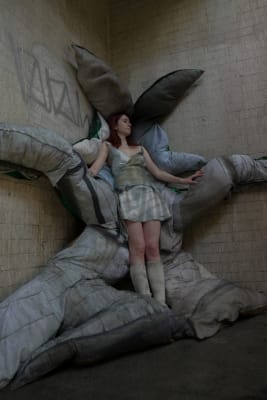
Safe space
This work focuses on reinterpreting parts of discarded or marginalized spaces in the city. The artist began this work by experiencing a clear hierarchy of spaces within the urban environment while living in London and Seoul. Numerous spaces within a city possess different levels of power based on ownership, accessibility, or degree, leading to the classification of urban spaces in a hierarchical structure. Among these spaces arranged in a hierarchical manner based on the degree of power, the artist focuses on to the spaces located at the bottom, which may be considered as abandoned, unused, or even discarded due to their lack of demands on humans and lack of management. These spaces, open to everyone, accommodate the most vulnerable social groups such as drug addicts or the homeless. However, the nature of these spaces being abandoned and consequently becoming risky is not predetermined from the beginning but is influenced by the surrounding environment, the system, the perspectives of individuals looking at this space, and the ways in which people deal with this space. On the other hand, consciously confronting and observing various types of spaces within the city leads to a sense that they are akin to living organisms rather than inanimate objects. For example, being inside a basement space with low ceilings and no windows, the body feels the sensation of the space's walls tightly pressed against its skin without air. Such membrane that provide a sensation of being tightly pressed against the body become another layer of skin. Also, in a pavilion with a glass ceiling, the crowd inside experiences a phenomenon where they cannot perceive the difference between the outside and the interior of the building while walking, and the glass ceiling of the pavilion can be likened to organs such as transparent lungs or intestines. In this way, after experiencing various sensations that living organisms can convey to each other within a space, I begin to think that parts or the entirety of the space are like organic entities. Once I perceive space as an organic entity, I start imagining what form the discarded and dangerous space, located at the bottom of the hierarchical structure, might take. The space that was previously judged as dangerous and discarded appears as a soft and plush organism that embraces people from every class. Therefore, this shift in perception raises questions about what a safe space, the opposite of a discarded and dangerous space, is. Is it impossible to find a unique form of a safe space that we envision? Does an absolute dangerous/safe space exist? This work poses such questions and aims to ultimately initiate a shift in perspective when looking at specific spaces and individuals, starting with imprinting the existence of gentle organisms in the individual's vision, rather than aiming to break or bend authoritative urban systems.

Safe space Look2 lookbook_3

Safe space Look2 lookbook_2

Safe space Look2 lookbook_1

Safe space Look1 lookbook_2

Safe space Look1 lookbook_1

Safe space creature wraping the body

Safe space creature wraps the body

Safe space creature and body
a body meets the creature

Safe space creature and body
a body finds a safe space creature

Safe space creature installation
a creature pops out from an abandoned space
To report inappropriate content, an infringement of copyright, or to report a problem on the Portfolio platform, please contact the Digital Team
